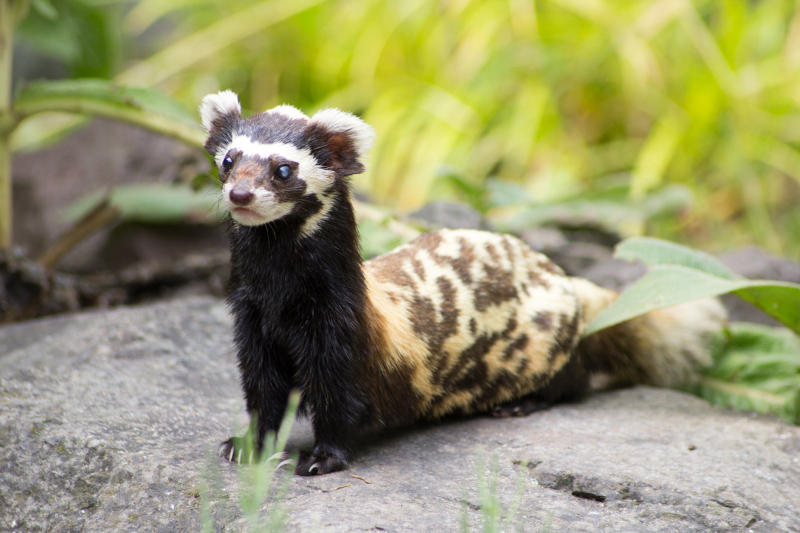
Marbled Polecat Facts
- The term of Marbled Polecat serves as the most frequently used common name for this intriguing product of Nature and evolution. It does have at least one other english language title, though. Though less often used, it’s sometimes called the tiger weasel.
- In many parts of its range, however, it’s known by various titles in different languages. Some of these include putois de Pologne, in French, and Tigeriltis in German, just to name a few. Regardless of which of these one uses, it remains a fascinating animal.
- Within scientific circles, though, it’s much better known by its technical name. Fortunately, that’s a relatively easy term for the layperson to pronounce. That’s because this distinctive member of its genus holds the official title of Vormela peregusna.
- The creature received that name due to the efforts of the Baltic German naturalist and explorer, Johann Anton Güldenstädt. He accomplished the first formal recognition of it as a separate and distinct species. That noteworthy event occurred in 1770.
- Sadly, the population of the Marbled Polecat has declined sharply in recent decades. That truly lamentable fact further appears to hold true throughout the entirety of its native range. The IUCN therefore presently lists it as Vulnerable on its Red List.
- The primary cause of this sigificant and ongoing reduction in its numbers seems to habitat loss. A reduction in available prey due to human activities also appears to factor in as well. Now, of course, the marvel faces the growing threat posed by climate change.
Related Articles
Marbled Polecat Physical Description
The beautiful Marbled Polecat possesses its own type of charm for those who encounter the creature. The animal exudes that charm, though, due more to its visual appeal than sheer physical size. That’s true since it’s moderately small compared to some of its many relatives.
LIke most of them, however, it also displays a certain degree of the physiological trait known as sexual dimorphism. In the case of this particular animal, that trait manifest itself in terms of dimensions. More precisely, the female remains smaller than their male counterpart.
That difference in terms of overall size remains minor, though. Both genders attain approximately the same head and body length. Females of the species tend to weight slightly less though, having a slightly thinner shape. Yet, exceptional individuals do occur.
The head and body length of both sexes averages 11.4 – 13.8 in (29 – 35 cm). The fluffy tail, meanwhile, typically adds an extra 5.1 – 8.7 in (13 – 22 cm). Males range in weight from 11.3 – 25.2 oz (295 – 600 gms). Shoulder heights for both equals 5.1 – 6.3 in (13 – 16 cm).
But it’s the coloring of the Marbled Polecat that’s its most appealing feature. The back presents a background of yellow, covered with a heavy mottline of irregular reddish-brown spots. The underside, though, shows a dark brown in all areas. The tail is brown and yellow.
The comparatively large ears represent yet another highly noticeable characteristic, however. It also has a shorter muzzle than many of its kindred. Its limbs develop as short, leaving its body close to the ground. It also shows a black and white face, and has long, strong claws.
- Kingdom: Animalia
- Phylum: Chordata
- Class: Mammalia
- Order: Carnivora
- Family: Mustelidae
- Genus: Vormela
- Species: V. peregusna
Marbled Polecat Distribution, Habitat, and Ecology
The beautiful Marbled Polecat appears to have evolved as native to an extremely broad swathe of the globe. The full extent of that zone of habitation might surprise you, though. That’s true since it appears from southeast Europe to Russia and certain portions of Asia.
In Europe, that range includes such countries as Bulgaria, Ukraine, and Romania. From there, its territorial range extends through Turkey, Mongolia, and Lebanon. Yet the resourceful mammal also makes its home in places like Afghanistan, Pakistan, and China.
The mammal is principally adapted to a specific type of habitat. The vast majority of its population appears in regions of either semidesert, open desert, and semiarid rocky regions. Many specimens also make their homes in areas consisting of steppe country.
As a general principle, the animal avoids higher altitudes. It does, however, live in various upland valleys and lower ranges of hills. The amazing species does display some adaptability, though. A small percentage of its numbers also live in arid subtropical scrub forests.
Like its relatives, the Marbled Polecat feeds primarily as a predator, though it does consume small quantities of vegetation. It’s mainly active during the morning and evening. Though it has weak eyesight, it has a keen sense of smell, enabling it to easily find its prey.
The small but efficient predator hunts a wide variety of smaller creatures. These include such species as voles, hamsters, ground squirrels, frogs, lizards, and numerous insects. It additionally compliments this fare with small amounts of various fruits and grasses.
Species Sharing Its Range
Red Veined Darter
Check out our other articles on 3 Surprising Sahara Desert Sites, Southern Darwin’s Frog, Gobi Desert, Rock Hyrax, Zebra Spider, Appalachian Avens, Snowflake Moray, Mangrove Monitor
